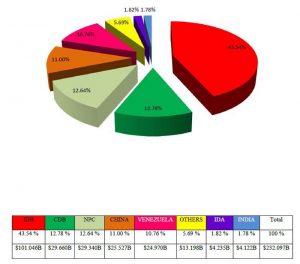Latest update February 8th, 2025 3:52 AM
Latest News
- AFC Leader Nigel Hughes welcomes any investigation into lands he acquired
- Pres. Ali defends Jagdeo’s attacks on critics
- VP Jagdeo tries to compare 75 acres of jungle lands Nigel Hughes wants to acquire with 35 acres of prime city lands sold to Ed Ahmad and others
- Greaves tells Govt ‘clean money’ used to acquire New York properties- Jagdeo
- Trump says Israel would hand Gaza to the US after fighting is over
APNU+AFC reduces external debt by 2.7%
Oct 23, 2016 News
Auditor General, Deodat Sharma, in his 2015 report, fixed Guyana’s external debt at US$1.16B. However, according to the Ministry of Finance, a debt management strategy developed under the APNU+AFC administration
has proven useful. The government has been able to reduce the figure to US $1.14B.
The Ministry’s half year report said that Guyana’s total public debt remained sustainable during the first half of 2016 as a result of a debt management strategy that is focused on ensuring that the government’s financing needs and payment obligations are met at a minimal cost.
According to the report, at the end of last June, Guyana’s total public debt amounted to just over US$1.552B, reflecting an increase of almost 1 percent compared to the 2015 half year position. Of the total public debt, external debt amounted to US$1.143B or 73.7 percent while domestic debt was $408.9M or 26.3 percent.
The report said that external public debt declined by 2.7 percent, from US$1.175B at the end of June 2015 to US$1.43B at end June 2016. This decline was mainly due to repayments of the oil debt to Venezuela in the form of rice and paddy shipments.
The report also stated that external principal and interest payments amount to US$27.1M during the first half of 2016, of which central government payments were US$24.5M.
Ministry of Finance said that compared with the previous year, total external debt service payments decreased by 46.9 percent. “This major reduction is a direct result of the decrease in debt service payments to Venezuela.
In July 2015, the PetroCaribe Arrangement and the Guyana -Venezuela Rice Trade Agreement (GVRTA) were halted.” This meant that there were no further shipments of rice and paddy to compensate for the oil debt to Venezuela. External disbursements significantly declined during the first half of 2016 in comparison to the same period last year.
At the end of June 2016, actual external disbursements total US$14.8M compared to US$51.0M at the end of June 2015. This 71 percent decrease was due to the abrupt halt of the PetroCaribe Arrangement, the completion of the Export -Import Bank of China E -Government Project and reduced disbursements from the multilateral creditors. In the first half of 2016, the multilateral creditors provided 86 percent of the external financing in comparison to 45 percent over the same period last year, while the bilateral creditors accounted for 14 percent of external disbursements at the end of June 2016 compared to 55 percent at the end of June 2015.
The report also noted that Guyana continues to accumulate significant arrears, totalling US$158.5 million at June 30, 2016, to its bilateral non-Paris Club and commercial creditors who did not participate in the Heavily Indebted Poor Countries (HIPC) Initiative.
The Government continues to actively engage these creditors with a view to debt write-offs. Some of these debts date back to the 1970s.
Share this:
- Click to print (Opens in new window)
- Click to email a link to a friend (Opens in new window)
- Click to share on Facebook (Opens in new window)
- Click to share on WhatsApp (Opens in new window)
- Click to share on Twitter (Opens in new window)
- Click to share on Pinterest (Opens in new window)
- Click to share on Pocket (Opens in new window)
- Click to share on Tumblr (Opens in new window)
- Click to share on Reddit (Opens in new window)
- Click to share on LinkedIn (Opens in new window)
Related
Similar Articles

The Glenn Lall Show | February, 3rd, 2025
Follow on Tik Tok @Glennlall
THE BLUNT OF THE DAY

Sports
Feb 07, 2025
2025 CWI Regional 4-Day Championships Round 2…GHE vs. CCC Day 2 -Eagles (1st innings 166-6, Imlach 58*) trail CCC by 209 runs Kaieteur Sports- Combined Campuses and Colleges (CCC) owned Day 2...Features/Columnists
What Guyanese leaders can learn from Donald Trump
Peeping Tom… Kaieteur News-There is little dispute that Donald Trump knows how to make an entrance. He does so without... more
OAS Secretary General Election and renewed OAS Consensus
Antiguan Barbudan Ambassador to the United States, Sir Ronald Sanders By Sir Ronald Sanders Kaieteur News- The upcoming election... more
Publisher’s Note
Freedom of speech is our core value at Kaieteur News. If the letter/e-mail you sent was not published, and you believe that its contents were not libellous, let us know, please contact us by phone or email.
Feel free to send us your comments and/or criticisms.
Contact: 624-6456; 225-8452; 225-8458; 225-8463; 225-8465; 225-8473 or 225-8491.
Or by Email: [email protected] / [email protected]
Weekend Cartoon
















